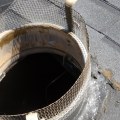Your attic is one of the most important parts of your home, and making sure it is properly ventilated is crucial to maintaining a comfortable and energy-efficient home. In this post, we'll discuss how attic fans and proper ventilation can help extend the life of your roof.
How Does an Attic Fan Work?
An attic fan is a type of exhaust fan that is installed in the attic of a house. The purpose of an attic fan is to ventilate the attic and remove heat and moisture. Attic fans are controlled by a thermostat, and they will turn on when the temperature in the attic reaches a certain level. The fans will run until the temperature in the attic is lowered to the desired level. They are usually installed by commercial roofers during new home construction.
How Can Attic Fan Help Extend the Life of Your Roof?
1. Attic fans help to circulate air and keep your attic cooler, which can take some of the strain off of your home's cooling system. This can lead to lower energy bills in the summer months.
2. Proper ventilation helps to prevent ice dams from forming, which can extend the life of your roof.
3. Attic fans help to reduce noise pollution by circulating air and reducing the build-up of sound waves.
4. Attic fans help to circulate air and improve the comfort of your home.
5. Attic fans help to keep your attic clean and free of dust, which can extend the life of your insulation.
6. Attic fans help to keep your attic dry, which can prevent the growth of mold and mildew.
7. Attic fans help to reduce the amount of heat that builds up in your attic, which can extend the life of your roof shingles.
8. Attic fans help to remove dangerous fumes and gases from your home, which can improve the air quality in your home.
9. Attic fans help to reduce the risk of fire by circulating air and keeping your attic cooler.
10. Attic fans help to improve the efficiency of your home's heating and cooling system, which can save you money on your energy bills.
These are just a few of the ways that attic fans can help to extend the life of your roof. If you're interested in installing an attic fan, you can search for a "commercial roofer near me" to find a roofing contractor who can help.
What to Consider When Installing an Attic Fan?
1. The size of the attic fan: The size of the attic fan should be based on the square footage of the attic. A larger attic will require a bigger fan.
2. The type of attic fan: There are two types of attic fans- whole house fans and gable fans. Whole house fans are more expensive, but they will cool your entire home. Gable fans are less expensive, but they will only cool the attic.
3. The location of the attic fan: The attic fan should be installed in a location that is away from any windows or doors to avoid drafts.
4. The type of insulation in the attic: There are two types of insulation- fiberglass, and cellulose. Fiberglass is cheaper, but it does not provide as much insulation as cellulose.
5. The R-value of the attic fan: The R-value is a measure of the thermal resistance of a material. The higher the R-value, the better the insulation. Attic fans with a higher R-value will be more expensive, but they will provide better insulation.
6. The warranty of the attic fan: Most attic fans come with a one-year warranty. Some companies offer longer warranties, but these are typically more expensive.
7. The installation of the attic fan: Installing an attic fan is not a difficult task, but it is important to follow the instructions carefully. Improper installation can result in leaks or drafts. It's best to have a qualified professional install the attic fan to ensure it is installed correctly.
Other Ways to Ventilate Your Attic
There are a few different ways that you can ventilate your attic. The most common methods are the use of gable vents, soffit vents, or ridge vents.
- Gable vents are installed in the gable end of the roof and allow air to flow into the attic.
- Soffit vents are installed under the eaves of the roof and allow air to flow out of the attic.
- Ridge vents are installed along the ridge of the roof and allow air to flow out of the attic.
Which method you use will depend on the design of your home and the amount of ventilation you need. Consult with a qualified professional to determine which method is best for your home.
How to Install an Attic Fan
Installing an attic fan is a relatively simple task, but it's important to follow the instructions carefully. Improper installation can result in leaks or drafts.
1. Choose the location for the attic fan. The attic fan should be installed in a location that is away from any windows or doors to avoid drafts.
2. Cut a hole in the ceiling for the attic fan. The size of the hole will depend on the size of the attic fan.
3. Install the mounting bracket for the attic fan. The mounting bracket should be installed according to the instructions that came with the attic fan.
4. Attach the attic fan to the mounting bracket.
5. Secure the wiring to the attic fan. The wiring should be attached to the attic fan according to the instructions that came with the attic fan.
6. Turn on the power to the attic fan. The switch for the attic fan is usually located near the Attic access door.
7. Test the attic fan to make sure it is working properly.
8. Install insulation around the attic fan. This will help to prevent drafts.
9. Close the access door to the attic.
If you are not comfortable installing the attic fan yourself, you can hire a qualified professional to do it for you. Some roofing contractors offer this service when they are installing a new roof.
Towson Commercial Roofer
Do you have an attic fan that needs to be installed or repaired? Towson Roofing Pros in Towson, MD is a reputable roofing company that offers attic fan installation and repair services. We have over 25 years of experience in the roofing industry, and our team of qualified professionals can install or repair your attic fan quickly and efficiently.
We offer free estimates and we are fully licensed and insured. It's important to choose a reputable roofing company when you need attic fan services. Many fly-by-night companies claim to be qualified roofers, but they are not. Choose a roofing company with a solid reputation like Towson Roofing Pros. Contact us today to schedule a free estimate.



